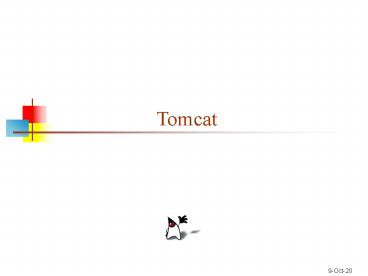Tomcat - PowerPoint PPT Presentation
Title:
Tomcat
Description:
The Apache Jakarta Project 'creates and maintains open source solutions on the ... Apache Jakarta Tomcat--or just 'Tomcat'--is one of those projects ... – PowerPoint PPT presentation
Number of Views:292
Avg rating:3.0/5.0
Title: Tomcat
1
Tomcat
2
The Apache Jakarta Project
- The Apache Jakarta Project creates and maintains
open source solutions on the Java platform for
distribution to the public at no charge - Apache Jakarta Tomcat--or just Tomcat--is one
of those projects - Tomcat is a container for servlets
- Tomcat can act as a simple standalone server for
Web applications that use HTML, servlets, and JSP - Apache is an industrial-strength, highly
optimized server that can be extended with Tomcat
3
Getting Tomcat
- The Apache Jakarta website is hard to navigate
- If you want to get Tomcat, one reasonable
download site is http//mirrors.xtria.com/apache/j
akarta/tomcat-5/v5.0.29/bin/ - You would need the whole tarball, which will
have a name such as jakarta-tomcat-5.0.29.tar.gz - An excellent tutorial site is Configuring Using
Apache Tomcat, http//www.coreservlets.com/Apache-
Tomcat-Tutorial/ - This site also contains many examples you can use
to test your installation - Installing Tomcat by itself is much easier than
installing Apache and then adding Tomcat to it
4
Web apps
- A web application is basically a web site that
- Knows who you are--it doesnt just give you
static pages, it interacts with you - Can permanently change data (such as in a
database) - A web application can consist of multiple pieces
- Static web pages (possibly containing forms)
- Servlets
- JSP
- Tomcat organizes all these parts into a single
directory structure for each web application - ...but you have to help with the organization
5
Directories
- To create servlets, you really should have two
directory structures - A development directory, in which you can write
and partially debug your code - A deployment directory, in which you put live
code - Tomcat requires a particular set of directories
for your web application - It is extremely picky about having everything in
the right place! - Since your web application must typically
co-exist with other web applications, you should
use packages to avoid name conflicts - This further complicates the Tomcat directory
structure
6
Packages
- A package statement in Java must be the very
first line of code in the file - Example
- package com.example.modelimport
javax.servlet.import javax.servlet.http.impo
rt java.io.public class MyServlet extends
HttpServlet ... - This implies that
- This program is in a file named MyServlet.java,
which is - in a directory named model, which is
- in a directory named example, which is
- in a directory named com
7
Tomcat directory structure
- myApplicationDirectory/ -- this is your top level
directory - myWebForm.html
- myJspPage.jsp
- WEB-INF/ -- must have this directory, named
exactly like this - lib/ -- mostly for external .jar files
- classes/ -- must have this directory,
named exactly like this - com/ -- The com.example.model package
directory - example/
- model/
- myModel.class -- in package
com.example.model - web/
- myServlet.class --in package
com.example.web - web.xml -- this is the deployment
descriptor, it must have this name
8
My files
- myWebForm.html
- This is the web page with a form that starts up
the servlet - com/example/web/myServlet.class
- This is the servlet I intend to use it will use
the myModel class, but to do this it needs an
import statementimport com.example.model.myModel
- com/example/model/myModel.class
- This does the business logic it is good form to
keep it separate - myJspPage.jsp
- The (optional) JSP page to create the HTML output
(could be done directly by myServlet) - web.xml
- A file required by Tomcat to tell it what class
to start with and how to refer to that class
9
myWebForm.html
lthtmlgt ... ltbodygt ... ltform
method"POST" action"NameSeenByUser.do"gt
...various form elements... lt/formgt
... lt/bodygt lt/htmlgt
10
web.xml
lt?xml version"1.0" encoding"ISO-8859-1"?gt ltweb-a
pp xmlns"http//java.sun.com/xml/ns/j2ee"
xmlnsxsi"http//www.w3.org/2001/XMLSche
ma-instance" xsischemaLocation
"http//java.sun.com/xml/ns/
j2ee/web-app_2_4.xsd"
version"2.4"gt ltservletgt
ltservlet-namegtSome internal namelt/servlet-namegt
ltservlet-classgtcom.example.web.MyServletlt/serv
let-classgt lt/servletgt ltservlet-mappinggt
ltservlet-namegtSome internal namelt/servlet-namegt
lturl-patterngt/NameSeenByUser.dolt/url-patter
ngt lt/servlet-mappinggt lt/web-appgt
11
Servlet without JSP
public class MyServlet extends HttpServlet
public void doPost(HttpServletRequest request,
HttpServletResponse
response) throws IOException,
ServletException response.setContentTyp
e("text/html") PrintWriter out
response.getWriter() String value
request.getParameter("name")
out.println("lthtmlgtltbodygtI got " name " "
value
"lt/bodygtlt/htmlgt")
12
Servlet with JSP
public class MyServlet extends HttpServlet
public void doPost(HttpServletRequest request,
HttpServletResponse
response) throws IOException,
ServletException String value
request.getParameter("name")
...computation resulting in some Object obj...
request.setAttribute(objName", obj)
RequestDispatcher view
request.getRequestDispatcher("result.jsp")
view.forward(request, response)
13
JSP (result.jsp)
lt_at_ page import"java.util." gt lthtmlgt ltheadgtlttit
legtYour resultslt/titlegtlt/headgt ltbodygt lt
MyObject object (MyObject)request.getA
ttribute("objName") String someResult
...computations using object...
out.print("ltbrgtAnd the answer is "
someResult) gt lt/bodygt lt/htmlgt
14
Flow
- The user submits an HTML form
- Tomcat finds the servlet based on the URL and the
deployment descriptor (web.xml) and passes the
request to the servlet - The servlet computes a response
- Either
- The servlet writes an HTML page containing the
response - Or
- The servlet forwards the response to the JSP
- The JSP embeds the response in an HTML page
- Tomcat returns the HTML page to the user
15
Alternatives to Tomcat
- Suns Java Web Server
- Old, no longer being developed, all in Java
- Java Web Server Development Kit (JWSDK)
- Official reference implementation
- Difficult to install and configure
- JBoss
- Open source
- Opinions vary on how easy it is to install
- Comes with built-in database
16
The End































